Fiber Optic Tech
Types of 800G Transceivers
800G optical transceivers have begun mass production recently. Due to the outbreak of AI technologies, the market demand for 800G optical modules has further increased. An 800G transceiver is a type of optical transceiver that is designed to transmit data at a rate of 800 gigabits per second (Gbps). This is significantly faster than the 400G transceivers that are currently the most common type of high-speed transceiver. 800G transceivers are still a relatively new technology, and they are not yet widely deployed. However, they are expected to become increasingly common in the coming years, as the demand for ever-increasing bandwidth continues to grow.
800G=8*100G=4*200G, so according to the single channel rate, it can be mainly divided into two categories, namely single channel 100G and 200G. The corresponding architecture is shown in the figure below. Single-channel 100G optical modules can be implemented quickly, while 200G has higher requirements for optical devices. Since the current maximum rate supported by the electrical interface is 112Gbps PAM4, for single channel 200G, requires gearbox for conversion.
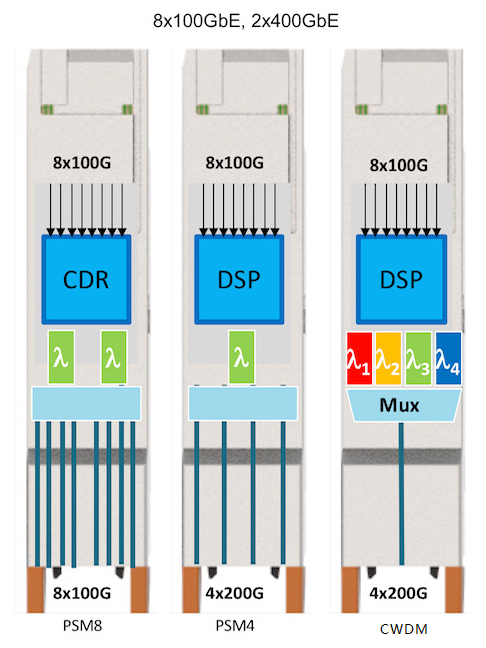
For multi-mode, there are two main 800G optical module standards, corresponding to transmission distances below 100m.
1) 800G Short-reach (SR8)
These transceivers are designed for short distances, typically up to 100 meters, and use multimode fiber. They are ideal for data center applications where high bandwidth is needed over short distances. Using the VCSEL solution, the wavelength is 850nm, the single channel rate is 100Gbps PAM4, and 16 optical fibers are required. This can be regarded as an upgraded version of 400G SR4, with the number of channels doubled. Its optical interface is MPO-16 or 2-row MPO-12.

2) 800G SR4.2
This solution uses two wavelengths, 850nm/910nm, to transmit signals of two wavelengths in a single fiber in both directions, which is called bi-directional transmission. DeMux needs to be used in the module to split the two wavelengths. The single channel rate is 100Gbps PAM4, which requires 8 optical fibers. Compared with SR8, the number of optical fibers in this solution is reduced by half. Its block diagram is shown in the figure below,
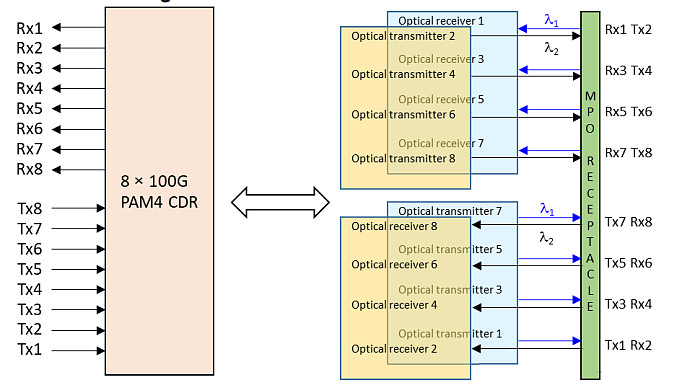
Its optical interface is shown in the figure below, using MPO-12 interface.

For single-mode, there are multiple standards for 800G optical modules.
3) 800G Medium-reach (DR8):
This is a medium-reach transceiver that uses eight lanes of 100Gbps PAM4 signaling and can transmit over distances of up to 500 meters on single-mode fiber.These transceivers are designed for medium distances. They are a good balance between cost and performance for many data center applications.
The internal architecture of the three standards of 800G DR8, 800G 2xDR4 and 800G PSM8 is similar, including 8 Tx and 8 Rx. The single channel rate is 100Gbps and requires 16 optical fibers.
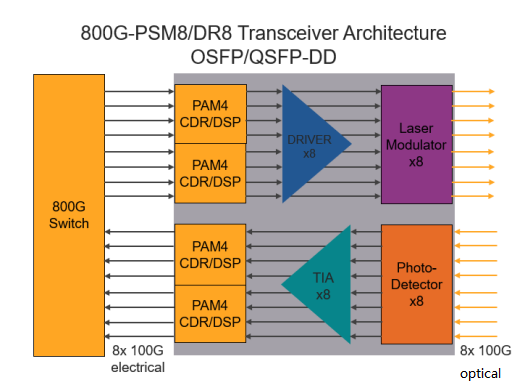
The transmission distance of PSM8 is 100m, while DR8 and 2*DR4 correspond to a transmission distance of 500m. The optical interface of 2xDR4 is 2 MPO-12, as shown in the figure below, which can be interconnected with 400G DR4 optical modules to facilitate data center upgrades. The optical interface of PSM8 and DR8 is MPO-16.
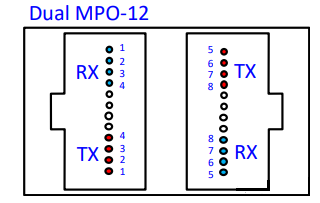
800G 2xFR4 and 2xLR4
The internal structures of these two standards are similar, including 4 wavelengths and a single channel rate of 100Gbps. The number of optical fibers is reduced through Mux, which requires 4 optical fibers, as shown in the figure below.
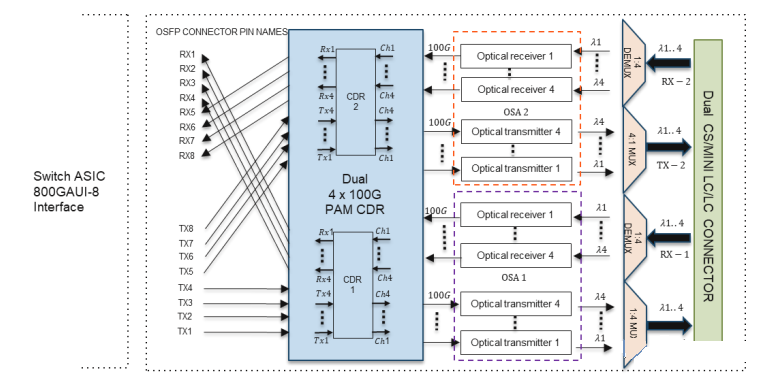
Both solutions are upgrades to 400G FR4 and LR4 optical modules, using CWDM4 wavelengths 1271/1291/1311/1331nm. 2xFR4 supports a transmission distance of 2km, and 2xLR4 supports a transmission distance of 10km. Its optical interface adopts dual CS or dual duplex LC interface.

4) 800G 2xDR4
This is a transceiver that uses two lanes of 400Gbps PAM4 signaling and can transmit over distances of up to 500 meters on single-mode fiber. It is essentially two 400G DR4 interfaces in one module.
5) 800G FR4
This solution uses four wavelengths, a single channel rate of 200Gbps, requires two optical fibers, and supports a transmission distance of 2km, as shown in the figure below.
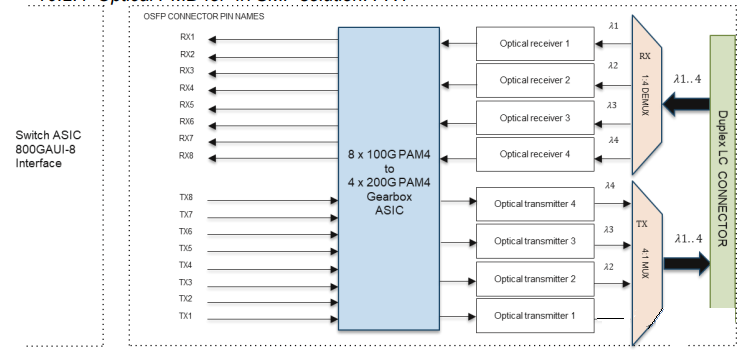
It uses duplex LC optical interface, as shown in the figure below.
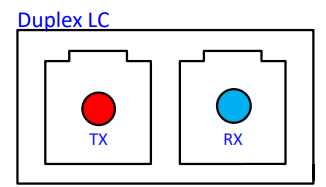
6) 800G Long-reach (FR8, LR8):
These transceivers are designed for long distances, typically up to 10km or more, and use single-mode fiber. They are used for applications such as connecting data centers that are located far apart. FR8 solution uses 8 wavelengths, each wavelength has a rate of 100Gbps, requires two optical fibers, and supports a transmission distance of 2km, as shown in the figure below. The eight wavelength channels are 1271/1291/1311/1331/1351/1371/1391/1411nm.
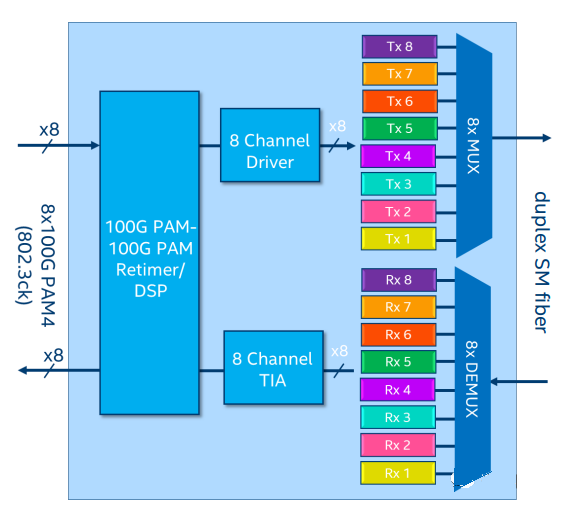
Both QSFP-DD and OSFP can support 800G. The comparison between the two is shown in the figure below. For the 800 optical module, QSFP-DD has made some supplementary s, namely QSFP-DD800. The main difference between the two:
1) Size, the size of OSFP is slightly larger.
2) Power consumption, the power consumption of OSFP is slightly higher than QSFP-DD.
3) Compatibility, QSFP-DD is perfectly compatible with QSFP28 and QSFP+, but OSFP is not compatible.
Overall, 800G transceivers are a promising new technology that has the potential to revolutionize the way that data is transmitted. However, there are also some challenges that need to be addressed before they can be widely deployed.



















